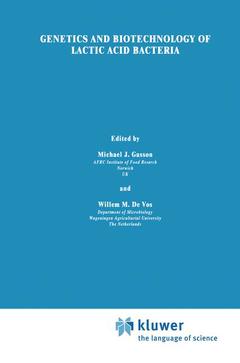Genetics and Biotechnology of Lactic Acid Bacteria, Softcover reprint of the original 1st ed. 1994
Langue : Anglais
Coordonnateurs : Gasson Michael J., de Vos W.

A prime reference volume for geneticists, food technologists and biotechnologists in the academic and industrial sectors. Fermentations with lactic acid bacteria determine important qualities such as taste, shelf-life, and food values. New methods of food production require fast and reliable manufacture, which has led to a dramatic surge of interest in the genetic, microbiological and biochemical properties of lactic acid bacteria.
1 Gene transfer systems and transposition.- 1.1 Introduction.- 1.2 Conjugation.- 1.2.1 Heterologous conjugation systems.- 1.2.2 Homologous conjugation systems.- 1.3 Transduction.- 1.3.1 Transduction in Lactococcus spp..- 1.3.2 Transduction in Streptococcus thermophilus.- 1.3.3 Transduction in Lactobacillus spp..- 1.4 Transformation.- 1.4.1 Transformation systems.- 1.4.2 Protoplast transformation.- 1.4.3 Electrotransformation.- 1.4.4 Transfection.- 1.5 Protoplast fusion.- 1.6 Transposition.- 1.6.1 Insertion sequences.- 1.6.2 Heterologous transposons.- 1.6.3 Nisin transposons.- 1.7 Generalized recombination.- 1.7.1 Integration processes.- 1.7.2 Recombination genes.- 1.8 Chromosome mapping.- 1.9 Concluding remarks.- References.- 2 Gene cloning and expression systems in Lactococci.- 2.1 Introduction.- 2.2 Replicative gene cloning.- 2.2.1 Streptoccal plasmid vectors.- 2.2.2 Lactococcal plasmid vectors.- 2.2.3 Plasmid replication and stability.- 2.3 Integrative gene cloning.- 2.3.1 Integration vectors.- 2.3.2 Chromosomal gene amplification and stability.- 2.3.3 Integrative gene expression.- 2.4 Gene expression signals.- 2.4.1 Vectors for the selection of expression signals.- 2.4.2 Transcription initiation and termination.- 2.4.3 Translation initiation and codon usage.- 2.5 Control of gene expression.- 2.5.1 Lactose utilization and its control.- 2.5.2 Heat shock response.- 2.5.3 Negative regulation of transcription.- 2.5.4 Positive regulation of transcription.- 2.6 Protein secretion.- 2.6.1 Export-signal selection vectors.- 2.6.2 Sec-dependent secretion.- 2.6.3 Sec-independent secretion.- 2.7 Expression and secretion systems.- 2.7.1 Expression vectors.- 2.7.2 Secretion vectors.- 2.8 Food grade systems.- References.- 3 Bacteriophages and bacteriophage resistance.- 3.1 Introduction.- 3.2 Types and species of bacteriophages.- 3.2.1 Interactions with hosts.- 3.2.2 Temperate phages.- 3.2.3 Classification of phages of lactic acid bacteria.- 3.2.4 Characterization of bacteriophage genomes.- 3.3 Gene directed bacteriophage resistance in lactic acid bacteria.- 3.3.1 Interference with bacteriophage adsorption.- 3.3.2 Restriction and modification.- 3.3.3 Abortive infection.- 3.4 Novel phage defense mechanisms.- 3.5 Genetic strategies to construct phage-insensitive strains.- 3.6 Conclusions and perspectives.- References.- 4 The proteolytic system of lactic acid bacteria.- 4.1 Introduction.- 4.2 Proteinases.- 4.2.1 Biochemical characterization.- 4.2.2 Caseinolytic specificity and classification of proteinases.- 4.2.3 Cloning and expression of proteinase genes.- 4.2.4 Organization of prtM and prtP genes.- 4.2.5 Structural characteristics of PrtP.- 4.2.6 Proteinase maturation by PrtM.- 4.3 Endopeptidases.- 4.3.1 Endopeptidase NisP.- 4.3.2 Intracellular endopeptidases.- 4.3.3 Endopeptidase PepO.- 4.4 General aminopeptidases.- 4.4.1 Aminopeptidase A (PepA).- 4.4.2 Pyrrolidonyl carboxylyl peptidase (PCP).- 4.4.3 Aminopeptidase N (PepN).- 4.4.4 Aminopeptidase C (PepC).- 4.5 Proline-specific peptidases.- 4.5.1 Prolidases.- 4.5.2 Proline iminopeptidase.- 4.5.3 X-prolyl dipeptidyl aminopeptidase (PepXP).- 4.6 Oligo-and carboxypeptidases.- 4.6.1Dipeptidases.- 4.7 Transport of amino acid and peptides.- 4.7.1 Specific amino acid carriers.- 4.7.2 Di- and tripeptide transport system (DptT).- 4.7.3 Oligopeptide transport system (Opp).- 4.8 Cellular localization of proteolytic enzymes.- 4.9 Engineering of the proteolytic system.- 4.9.1 Construction and use of mutants.- 4.9.2 Engineering of the proteinase PrtP.- 4.9.3 Future perspectives.- References.- 5 Bacteriocins of lactic acid bacteria.- 5.1 Introduction.- 5.2 Small heat-stable bacteriocins.- 5.2.1 Genetic analysis.- 5.2.2 Common structural features.- 5.2.3 Bacteriocin translocation.- 5.2.4 Mode of action.- 5.3 Large heat-labile bacteriocins.- 5.3.1 Helvetican J.- 5.4 Lantibiotics in lactic acid bacteria.- 5.4.1 Lactocin S.- 5.4.2 Lacticin 481.- 5.4.3 Nisin structure and biosynthesis.- 5.4.4 Genetic analysis of nisin biosynthetic genes.- 5.4.5 Expression of nisin determinants.- 5.4.6 Nisin immunity resistance.- 5.4.7 Mode of action.- 5.4.8 Protein engineered nisins.- 5.4.9 Applications.- 5.5 Concluding remarks.- References.- 6 Genetic engineering of lactobacilli, leuconostocs and Streptococcus thermophilus.- 6.1 Introduction.- 6.2 Overview of taxonomy and health benefits.- 6.3 Biochemical traits.- 6.3.1 The Lac-PTS.- 6.3.2 The lac operon.- 6.3.3 Xylose metabolism.- 6.3.4 Protein metabolism.- 6.4 Plasmid biology and cloning vectors.- 6.4.1 Naturally occuring plasmids.- 6.4.2 Insertion sequences.- 6.4.3 Cloning vectors.- 6.5 Genetic transfer methods.- 6.5.1 Transformation by electroporation..- 6.5.2 Liposome-mediated protoplast transfection, fusion and transformation.- 6.5.3 Conjugation.- 6.5.4 Transduction.- 6.6 Gene expression in lactobacilli.- 6.6.1 Transcription.- 6.6.2 Translation.- 6.6.3 Regulation of transcription.- 6.6.4 Heterologous gene expression.- 6.7 Gene expression in S. thermophilus and leuconostocs.- 6.8 Chromosomal integration of genes.- 6.9 Phage and phage resistance.- 6.10 Concluding remarks.- Dedication and acknowledgements.- References.
The contributions take an academic approach in that they emphasise the basic research underlying potential applications themselves. The comprehensive cover of these areas should prove invaluable to workers in the field. This volume will also provide an excellent introduction to these bacteria for geneticists more familiar with other species. - Journal of Chemical Technology and Biotechnology, ...will supply a rich source of information for researchers new to the field as well as providing a broad reference base for specialists...may prove inspirational for new research - Society for General Microbiology Quarterly, This book will be indispensable to anyone embarking on a career in research in the area of molecular biology of lactic acid bacteria and will certaintly have something to offer current researchers. - The Genetic Engineer and Biotechnologist
Date de parution : 10-2012
Ouvrage de 300 p.
15.5x23.5 cm
Thèmes de Genetics and Biotechnology of Lactic Acid Bacteria :
Mots-clés :
Amino acid; Carrier; Chromosome; Termination; Translation; Transport; biosynthesis; gene expression; gene transfer; genetics; lactose; metabolism; mutant; recombination; transcription
© 2024 LAVOISIER S.A.S.



